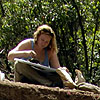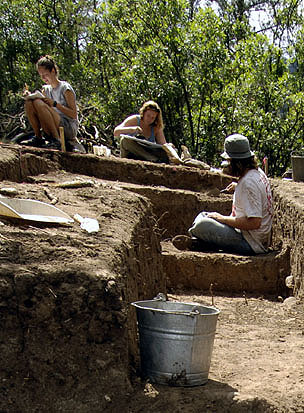Combined Archaeology Field School Begins at SMU-in-Taos
SMU-in-Taos begins a unique partnership with students and faculty from Mercyhurst College.


“This collaboration will create one of the strongest archaeology field training programs in the nation, if not the world,” said Mike Adler, SMU-in-Taos executive director. “It leverages the strengths of both institutions.”
Members of the public are invited to help celebrate the new partnership at an open house scheduled for Tuesday, June 30, which will include tours of open archaeological excavations at the Laundresses Quarters of the pre-Civil War U.S. Cavalry cantonment located on the SMU-in-Taos campus.
Tours will begin at the top of the hour from 9 – 11 a.m. and from 2 – 4 p.m. Directions to the campus, located on New Mexico Highway 518 between Ranchos de Taos and Penasco, are available online.
Mercyhurst President Thomas J. Gamble and Provost James Adovasio, who also directs the Mercyhurst Archaeological Institute, will join Thomas Tunks, SMU Associate Provost and James E. Quick, SMU Associate Vice President for Research and Dean of Graduate Studies for a formal signing ceremony to mark the agreement, also on June 30.
The first session of the Taos Collaborative Archaeology Program (TCAP) runs June 1 through July 15, joining 12 students from SMU with 16 from Mercyhurst. SMU’s TCAP director is Sunday Eiselt, assistant professor of anthropology, and Mercyhurst field directors are Judith Thomas, a historic archeologist, and Joseph Yedlowski, a prehistoric archeologist.
SMU is now in its fourth decade of offering field archaeology at the Taos campus, and Adler estimates more than 1,000 undergraduate and graduate students have trained there.
“We have a lot to learn from each other,” Thomas said. “SMU is very strong in community-based archaeology and they have a top facility at which to study. We provide an intense, hands-on field archaeology experience using state-of-the art technology.” The Mercyhurst group is supplying a new remote sensing device known as a gladiometer that works in tandem with computer software to generate subsurface maps and better target excavation efforts.
The students will excavate at the Ranchos de Taos Plaza in the shadow of the historic San Francisco de Asis church, and in the homes and backyards of Ranchos de Taos residents whose willingness to work with SMU is a hallmark of the program. Students will also take part in the annual mudding of the church and will record rock art near the spectacular Rio Grande Gorge. And because the SMU-in-Taos campus is sited on an archaeological treasure trove, program participants will have ready access to the restored Fort Burgwin, a pre-Civil War U.S. Cavalry cantonment, and the 13th-century Pot Creek Pueblo.
SMU-in-Taos has offered summer education programs tailored to the region’s unique resources since 1973, but the rustic campus dormitories were impractical for use during colder weather. New construction, recent renovations to housing and technological improvements provided through a $4 million lead gift from former Texas Gov. William P. Clements and his wife, Rita, will allow SMU students to take a full semester of classes for the first time this fall.
Other donors have given more than $1 million to support the student housing. They include Dallas residents Roy and Janis Coffee, Maurine Dickey, Richard T. and Jenny Mullen, Caren H. Prothro, and Steve and Marcy Sands; Bill Armstrong and Liz Martin Armstrong of Denver; Irene Athos and the late William J. Athos of St. Petersburg, Fla.; Jo Ann Geurin Thetford of Graham, Texas; and Richard Ware and William J. Ware of Amarillo, Texas.
# # #